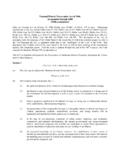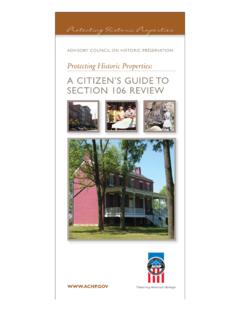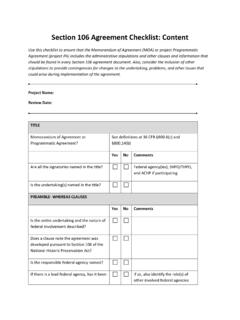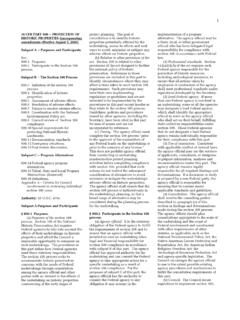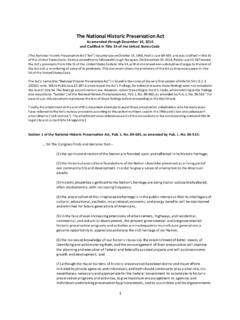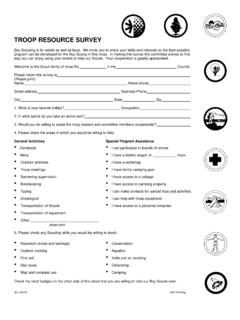Transcription of SECTION 106 ARCHAEOLOGY GUIDANCE
1 SECTION 106 ARCHAEOLOGY GUIDANCE (available online at ) (current as of 01/01/2009) I. INTRODUCTION A. Purpose of the GUIDANCE . The Advisory Council on Historic Preservation s SECTION 106 ARCHAEOLOGY GUIDANCE is designed to assist federal agencies in making effective management decisions about archaeological resources in completing the requirements of SECTION 106 of the National Historic Preservation Act (NHPA) ( ) [16 470f] and its implementing regulations, Protection of Historic Properties [36 CFR part 800] ( ). To encourage both effective and efficient consideration of ARCHAEOLOGY in planning, this GUIDANCE highlights the decision-making role of the federal agency in the SECTION 106 process.
2 This document is also designed for use by State and Tribal Historic Preservation Officers (SHPOs/THPOs), Indian tribes, Native Hawaiian organizations (NHOs), and cultural resource management professionals when assisting federal agencies to meet their responsibilities under SECTION 106. This document presents non-binding GUIDANCE . B. Web-based presentation and long-term vision of assistance. This GUIDANCE is presented in an interactive, Web-based format as a series of questions and answers. It is designed to be a dynamic document, with examples used to illustrate the points and perspectives made here.
3 Each question has a unique answer. However, the answers complement each other in such a way that, when considering a specific question or topic, the user is strongly encouraged to access links to other answers and their questions, as suggested. Also, links to pertinent federal law, regulation, standards, and GUIDANCE are provided. Accessing this additional information offers the user a more thorough explanation. We invite you to send your feedback on this GUIDANCE , your recommendations on additional ARCHAEOLOGY topics that should be considered, and examples of successful SECTION 106 outcomes to C.
4 Topics covered. The questions and answers are grouped under five main categories that mirror the steps in the SECTION 106 process (a complete list of questions can be found in the index at the end of this document): Getting started in the SECTION 106 process SECTION 106 consultation about ARCHAEOLOGY Determining which archaeological sites are significant Reaching agreement on appropriate treatment Completing the SECTION 106 process D. Terms used in the GUIDANCE . A historic property (or historic resource) is defined in the NHPA [16 470w(5)] as any prehistoric or historic district, site, building, structure, or object included in, or eligible for inclusion on, the National Register of Historic Places, including artifacts, records, and material remains related to such a property or resource.
5 Following National Register Bulletin No. 36, Guidelines for Evaluating and Registering Archaeological Properties ( ), an archaeological site is a location that contains the physical evidence of past human behavior that allows for its interpretation. The term archaeological site refers to those that are eligible for or are listed on the National Register (historic properties) as well as those that do not qualify for the National Register. The commonly used term cultural resource does not have a consistent or legal definition. The significance of a property refers to its ability to meet one of the four National Register criteria (A-D) ( ).
6 According to National Register Bulletin No. 15, How to Apply the National Register Criteria for Evaluation ( ), [t]he quality of significance in American history, architecture, archeology, engineering, and culture is present in districts, sites, buildings, structures, and objects that possess integrity of location, design, setting, materials, workmanship, feeling, and association and that meet one or more of the four criteria (A-D). Integrity is the ability of the property to convey this significance through physical features and context. Historic properties are significant because they do meet these criteria and have integrity.
7 Pursuant to SECTION 101(d)(6)(A) of the NHPA, properties of traditional religious and cultural significance to an Indian tribe or NHO may be deemed eligible for listing on the National Register (See Consulting with Indian Tribes in the SECTION 106 Review Process at ). Indian tribes, NHOs, ethnic or religious groups, communities, professional and other organizations, or the public may ascribe a cultural, historical, or religious value to an archaeological site. The term value here refers to the site s worth and importance to them and their experience, regardless of whether the site possesses National Register significance.
8 For example, an archaeological site may be of historical or cultural value to the Mormons, or to an African-American community (See the description of the African Burial Ground at ), or to the Order Sons of Italy in America, with or without its meeting the criteria for listing in the National Register. Mitigation is a way to remedy or offset an adverse effect or a change in a historic property s qualifying characteristics in such a way as to diminish its integrity. Treatment is the act of mitigating those effects, or how one goes about implementing the mitigation measure(s) agreed upon in consultation.
9 Thus, a mitigation plan for the undertaking may contain several treatment plans, one for each property being adversely affected. Data recovery is a common mitigation measure that, through implementation of a treatment plan, retrieves the important information present within an archaeological site that makes it eligible before the site s integrity is compromised or destroyed. II. BACKGROUND A. ARCHAEOLOGY under SECTION 106. The Advisory Council on Historic Preservation s (ACHP) primary involvement with ARCHAEOLOGY is through SECTION 106 review. It has been estimated that more than 90 percent of the archaeological excavations conducted in the United States are done so pursuant to SECTION 106 of the NHPA.
10 Responsibilities for ARCHAEOLOGY under SECTION 106 extend to undertakings such as construction projects and land and resource planning efforts occurring on federal lands, as well as those where federal agencies provide funding or issue licenses, permits, or approvals for actions on non-federal lands, including tribal, state, municipal, and private property. 2 Archaeological sites are identified and evaluated under SECTION 106 by federal agencies for their eligibility for listing in the National Register. Through consultation with stakeholders, such as State and Tribal Historic Preservation Officers, Indian tribes, and Native Hawaiian organizations, federal agencies take into account the effects of their undertakings on eligible or listed archaeological sites.
